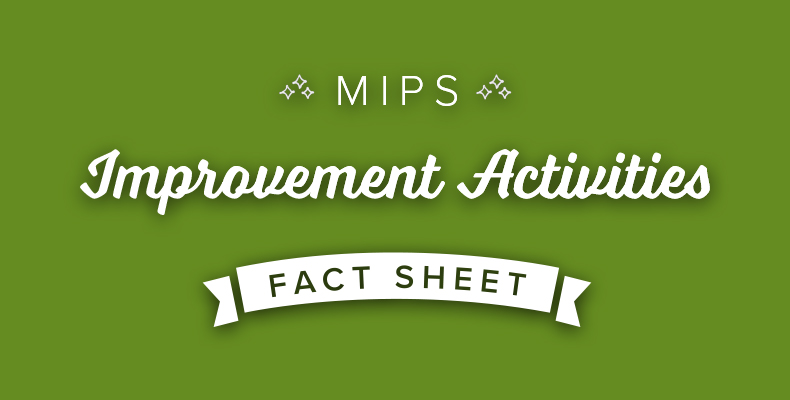
The Medicare Access and CHIP Reauthorization Act of 2015 (MACRA) replaced a patchwork collection of reporting programs with a single system where Medicare physicians and clinicians have a chance to be rewarded for better care. You’ll be able to practice as you always have, but you may receive higher Medicare payment based on your performance. There are two paths in this program:
- Merit-based Incentive Payment System (MIPS)
- Advanced Alternative Payment Models (APMs)
Under MIPS, there are four connected performance categories that will affect your Medicare payments – quality, clinical practice improvement activities (referred to as “improvement activities”), use of certified EHR technology (referred to as “advancing care information”), and resource use (referred to as “cost”).
Focusing on Improvement Activities for MIPS
The Improvement Activities performance category within MIPS assesses how much you participate in activities that improve clinical practice. Examples include ongoing care coordination, clinician and patient shared decision making, regular implementation of patient safety practices, and expanding practice access. Under this performance category, you’ll be able to choose from many activities to demonstrate your performance. This performance category also includes incentives that help drive participation in certified patient-centered medical homes and APMs.
Choosing Improvement Activities
You’ll be able to choose from activities listed under the Improvement Activity inventory. The inventory for the first year of MIPS is currently listed on the Quality Payment Program Website as well as in Table H of the Appendix in the Quality Payment Program Final Rule. The inventory contains activities that are divided into 9 subcategories:
1. Expanded Practice Access
2. Population Management
3. Care Coordination
4. Beneficiary Engagement
5. Patient Safety and Practice Assessment
6. Participation in an APM
7. Achieving Health Equity
8. Integrating Behavioral and Mental Health
9. Emergency Preparedness and Response
Submitting Improvement Activities
Eligible clinicians may submit their improvement activities by attestation via the CMS Quality Payment Program website, a qualified clinical data registry, a qualified registry, or, when possible, from their electronic health record system. Groups of 25 or more may choose to use the CMS Web Interface. Eligible clinicians and groups only need to attest via the Quality Payment Program website that they completed the improvement activities they selected or should work with their vendor to determine the best way to submit their activities via a qualified clinical data registry (QCDR), a qualified registry, or their electronic health record system.
Eligible clinicians are encouraged to retain documentation for 6 years as required by the CMS document retention policy.
Reporting criteria
- You must attest by indicating “Yes” to each activity that meets the 90-day requirement (activities that you performed for at least 90 consecutive days during the current performance period).
- You may report activities using a qualified registry, via certified EHR Technology), qualified clinical data registry (QCDR), the CMS Web Interface (for groups of 25 or more), or via attestation. These intermediaries will need to certify that you performed the activities as indicated.
- You can choose to attest to the set of activities that are most meaningful to your practice since there are no subcategory reporting requirements. That is, you don’t have to select activities in each subcategory or select activities from a certain number of subcategories.
- If you choose to participate in MIPS via a QCDR, you must select and achieve each improvement activity separately. You will not receive credit for multiple activities just by selecting one activity that includes participation in a QCDR.
The Improvement Activity performance category counts for 15% of your MIPS final score, unless you or your group is subject to the APM Scoring Standard. If the APM Scoring standard applies, the weight of the improvement activity score toward the final score depends on the APM. See below for more information about APM participation.
Understanding Your Score
Groups with more than 15 clinicians
Each activity is weighted either medium or high. To get the maximum score of 40 points for the Improvement Activity score, you may select any of these combinations:
- 2 high-weighted activities
- 1 high-weighted activity and 2 medium-weighted activities
- Up to 4 medium-weighted activities
Each medium-weighted activity is worth 10 points of the total Improvement Activity performance category score, and each high-weighted activity is worth 20 points of the total category score.
If you are not participating in an APM, a certified patient-centered medical home or comparable specialty practice, and you do not select any activities, you will receive 0 points in this performance category.
Scenario: Dr. Joy Smith is in a practice of more than 15 clinicians, and she could get 40 points for the Improvement Activity score by selecting 1 medium-weighted activity from the Beneficiary Engagement Subcategory, 1 medium-weighted from Patient Safety and Practice Assessment Subcategory, and 1 high weighted activity from the Integrated Behavioral Health Subcategory.
Groups with 15 or fewer clinicians, non-patient facing clinicians and/or clinicians located in a rural area or HPSA
Again, each activity is weighted either medium or high. To achieve the maximum 40 points for the Improvement Activity score, you may select either of these combinations:
- 1 high-weighted activity
- 2 medium-weighted activities
For these clinicians, each medium-weighted activity is worth 20 points of the total Improvement Activity performance category score, and a high-weighted activity is worth 40 points of the total category score. These clinicians may select two medium-weighted activities or one high-weighted activity to receive a total of 40 points of the total category score.
APM Participants
Certified Patient-Centered Medical Home Participants
You can get full credit for the Improvement Activities performance category if you’re practicing in a certified patient-centered medical home, including Medical Homes Model, or a comparable specialty practice. For multi-practice groups, if only one group is certified as a Patient-Centered Medical Home, the entire group (under the same Taxpayer Identification Number (TIN) can still get full credit.
Eligible Clinicians Participating in an APM (not a MIPS APM)
If you’re an eligible clinicians participating in an APM and your TIN/NPI also appears on the APM Participant List at any time during the performance period, you can get credit for participating in an APM and receive one half of the total points for the MIPS Improvement Activity performance category score for that performance year.
MIPS APM Participants
If you participate in a MIPS APM and are included on the APM’s participant list on one of the three assessment dates, March 31, June 30 or August 31, you will be scored for all four of the MIPS performance categories under the APM Scoring Standard. The Improvement Activity score for eligible clinicians in MIPS APMs is assigned to the APM prior to the beginning of the performance period and can be found at QPP.CMS.GOV.
Shaping Future Improvement Activities
Improvement Activity Study
In January 2017, and annually thereafter, we began to study whether clinical quality workflows and data capture using a simpler approach to quality measurement results in improved outcomes, reduces reporting burden, and enhances clinical care. This Improvement Activity study will be open to:
- Up to 10 non-rural individual MIPS eligible clinicians, or groups of less than 3 non-rural eligible clinicians
- 10 rural individual clinicians, or groups of less than 3 rural clinicians
- 10 groups of 3-8 clinicians
- 5 groups of 9-20 clinicians
- 3 groups of 21-100 clinicians
- 2 groups of more than 100 clinicians
- 2 specialist groups of clinicians
Those who participate will be required to submit data at least quarterly, attend a monthly focus group, and provide feedback. At the end of the first performance period, participants who have followed study guidelines will get 40 points for the performance category, and will be given the option to either continue to participate during the next year or opt-out. Those who join the study but fail to meet requirements will be removed, and will have to meet the full requirements of the performance category.
CMS will announce the study annually via the Quality Payment Program Listserv for interested participants.
MIPS Annual Call for Improvement Activities
The Annual Call for Measures and Activities, in which occurred between January 2017 through February 2017, and each January thereafter, allows clinicians and organizations, including but not limited to those representing eligible clinicians such as professional associations, and medical societies, and other stakeholders such as researchers and consumer groups to identify and submit for consideration:
- Quality measures for the quality performance category;
- EHR measures for the advancing care information performance category; and
- Activities for the improvement activities performance categories for consideration.
MIPS improvement activities, submitted for consideration, should demonstrate robust clinical performance supporting patient-centered care, further clinical achievement in the other categories of MIPS, enable clinicians and groups to join or become APMs, and improve public health. A direct link to the annual call fact sheet is provided below.
Additional Resources
We’re committed to keeping you updated and getting your feedback throughout the implementation of the program. To get the latest information, visit the Quality Payment Program Website and join our listserv.
- MIPS Annual Call for Measures and Activities Fact sheet
- CMS Document Retention Policy
- Quality Payment Program can be reached at 1-866-288-8292 (TTY 1-877-715- 6222), available Monday through Friday, 8:00 AM-8:00 PM Eastern Time or via email at [email protected]





